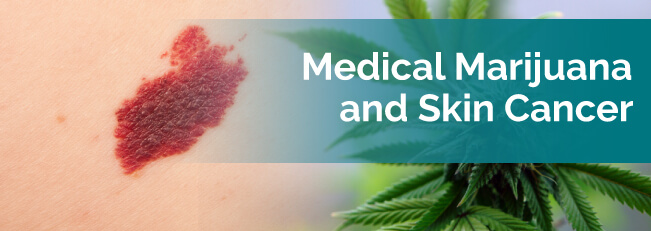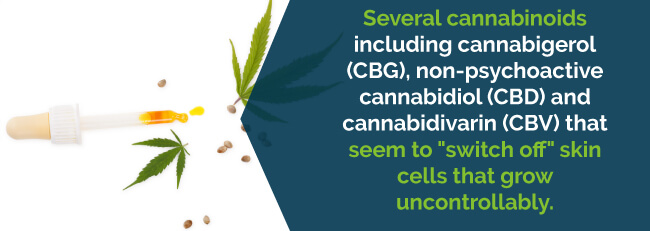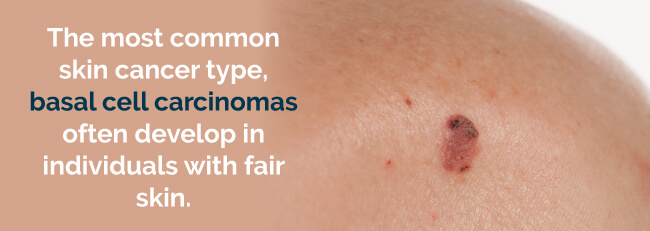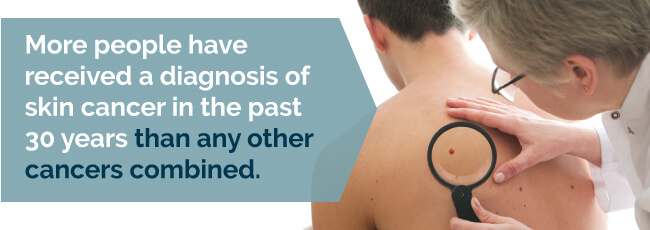
Skin cancer is the most common type of cancer. If you suspect you have it, it’s essential that you go to your doctors and receive an official diagnosis to determine which kind of skin cancer you have. Knowing the type of cancer you have affects your prognosis and your options for treatment. Medical marijuana for skin cancer might be an ideal treatment to help you with your cancer symptoms and the side effects of treatment.
The skin is the largest organ of the body. It serves many important functions including protecting the body from infection and regulating body temperature in fluids. The skin is primarily composed of three layers. The epidermis is the outer layer of the skin and contains basal and squamous cells. Melanocytes are also found in the epidermis. These are cells that contain pigment which allows the skin to tan and which also protect the deeper layers of the skin from the effects of UV sunlight exposure. The dermis, which lies below the epidermis, contains blood vessels, connective tissue, hair follicles and sweat glands. The subcutaneous layer, which contains the deepest layer of skin contains fat cells and collagen. Skin cancer occurs when there is an uncontrollable growth of abnormal cells in a layer of the skin. There are three common forms of skin cancer that are distinguished by the types of cells affected. Basal cell carcinoma is the most common form of skin cancer. This type of skin cancer does not typically spread but does require treatment. Basal cell carcinomas most often develop in areas of the skin exposed to the sun. Squamous cell carcinomas develop in the middle layer of the epidermis. This type of cancer can spread and can be life-threatening if not treated appropriately. Abnormal growths of malignancies called malignant melanomas are the most aggressive form of skin cancer. Melanomas can spread quickly to other parts of the body and to organs. This type of skin cancer can be fatal if not detected and treated early. People with fair skin are at increased risk for developing this form of cancer. Increased sun exposure and a history of sunburns increase the risk for developing skin cancer. Learn more below about how medical marijuana can help treat skin cancer.
Hemp oil contains cannabidiol (CBD) and other cannabinoids, vitamins, minerals and many other components that have an array of health benefits. When you apply hemp oil topically, your skin absorbs it. Your skin contains cannabinoid receptors that make CBD a potential treatment for many conditions that range from dry skin to skin cancer. Since you apply CBD hemp oil directly on trouble areas, it works where you need it most without absorbing into your bloodstream.
The British Journal of Pharmacology published a peer-reviewed study showing several cannabinoids including cannabigerol (CBG), non-psychoactive cannabidiol (CBD) and cannabidivarin (CBV) that seem to “switch off” skin cells that grow uncontrollably. Uncontrolled growth of this kind is a factor in skin allergies and skin cancers.
Find A Doctor Find A Dispensary

In this study, the researchers documented the effects of these three cannabinoids on human skin cell lines. CBD was the most effective of the three in addressing unwanted DNA activity, with CBG coming in second. Although THC works as an effective skin allergy treatment, researchers are directing their attention to compounds in cannabis that don’t get you high, since many patients find that option more appealing.
The researchers in the study claim phytocannabinoids such as CBD that appear to stop detrimental DNA activity that promotes skin cancer may also be a new treatment that may help “switch off” unwanted gene activity on a larger scale.
In another study, carried out by the Tokyo Metropolitan Institute of Public Health, and published in the Journal of Pharmacy and Pharmacology, researchers discovered that cannabinoids reduced skin cancer by 90 percent over a 20-week period.
A 2009 study explored the effects of cannabinoid receptor activation in living beings with skin cancer. Many initial studies use isolated cells in a container like a test tube. Advancing to living animals like mice can give us a better idea of how we can apply the results to humans, so the team behind this study examined the receptors in healthy skin and tumors in mice and humans.
Cannabinoids reduced cancer growth and spread across the board. They triggered cell death and lowered growth rates in the cells they administered cannabinoids to. Also, even though they killed cancerous tissue, normal tissue was left undamaged. If more data shows cannabis can kill cancer without hurting the rest of the body, we can make great developments in cancer treatment. Current therapies like chemotherapy don’t discriminate between tissues, causing harm to healthy cells, as well.
The team also found a few other details of note that can inform how we treat cancer with cannabis. As part of their methods, they tried using only cannabinoids that worked with the CB2 receptor when they looked at cancer cell death, which let them simulate treatment without making the mice subjects feel “high.” Also, cannabinoids seemed to decrease the activation of a compound that triggers tumor growth, cutting it off before it began.
Marijuana for skin cancer can help ease a variety of symptoms that cancer and cancer treatment cause, such as:
Anorexia is a medical term that doctors use for “loss of appetite.” The FDA approves Dronabinol (a synthetic cannabinoid) for anorexia-linked to AIDS, but not cancer specifically. However, medical cannabis increases a person’s appetite.
Other symptoms may include:
Although all medical weed offers similar therapeutic benefits, there are specific effects of indica and sativa that are different from one another.
Benefits of indica include:
Benefits of sativa include:
Hybrid forms of medical pot provide a cross-section of benefits. Many hybrid strains increase relaxation and reduce nausea.
Some cannabis strains to consider and the symptoms they treat include:
By experimenting with different methods of marijuana and skin cancer treatment, you’ll identify which therapy works best for you. There are various ways to reap the benefits of cannabis — each with its own unique experience.
Standard cancer treatments like radiation and chemotherapy can cause damage that requires repair before you can begin your marijuana treatment. A suppository of high-CBD cannabis oil may help purge your body of radiation after receiving radiation treatment. You may not like the idea of this method of therapy, but it’s a step you can take after receiving radiation to help prevent cancer recurrence. You won’t get “high” with this method, but you may feel relaxed after you apply the oil on your skin.
Another possible treatment method is a transdermal patch. Transdermal patches work off your skin with a steady dose of marijuana and a controlled release of cannabinoids required for acting on cancer.
Smoking medical weed provides you with fast relief from your nausea, pain and other symptoms.
When deciding to use cannabis treatment, many people try the edible products. There is a variety of ways you can ingest your pot including brownies, crackers, cookies, chocolate bars, chews and even lollipops and ice cream. The relief you get will last for a while.

Use topical solutions like ointments, salves, lotions, sprays and other to relieve joint pain, muscle soreness and other problems. You get an effective treatment to relieve localized pain without getting “high.”
Vaporizing is another method of inhaling but is not as harsh on your lungs as smoking is.
Tincture products offer a way for you to spray or squirt your treatment into your mouth. Tinctures are usually a mixture of glycerin, cannabinoid oil and extracts or alcohol. With this method, you can control your dosage easily.
Medical weed can also come in the form of a suppository. With this method, the active ingredients absorb through your colon quickly and you feel the effects just as fast.
When you consume fresh cannabis, you’re preserving all the active ingredients and contents, even the ones that might be reduced or eliminated during the heating or drying process. Juices and smoothies are the best way to ingest your fresh cannabis.
Search for a medical marijuana doctor today to begin your cannabis for skin cancer treatment to alleviate your skin cancer symptoms. We can connect you with quality medical marijuana doctors in all legal marijuana states across the country to ensure you comply with your state laws. Let us help improve your quality of life by booking an appointment today.
Find A Doctor Find A Dispensary
Skin cancer occurs when you have abnormal skin cells that grow uncontrollably. It happens when you have skin cells with unrepaired DNA damage (usually by UV sun rays or tanning beds), which trigger mutations that lead the cells to rapidly multiply and turn into malignant tumors. Genetic defects are also a factor.
There are several types of skin cancer including:
This type of skin cancer is the deadliest form. Melanoma often appears suddenly on your skin as a new dark spot or as a mole. It’s important that you receive a diagnosis early and treatment.
AKs are scaly, dry spots or patches and are precancerous growths. Individuals with AKs typically have fair skin and don’t usually notice their first AKs until after they’re 40 years old since AKs often grow after years of sun exposure.

The most common skin cancer type, basal cell carcinomas often develop in individuals with fair skin. They look like pearl-like, flesh-colored bumps or pink patches on your skin and are caused by indoor tanning or frequent sun exposure. Without treatment, they can grow into your bones and nerves, invade surrounding tissue and cause disfigurement and damage.
Squamous cell carcinoma is the next most common skin cancer and develops in people with light skin. SCC often looks like a scaly patch, a red firm bump or a sore that comes and goes. Frequent sun exposure is usually the cause, and without treatment, SCC can grow deep into your skin causing disfigurement and damage.
Merkel cell carcinoma is a form of skin cancer that’s not very common. It starts when skin cells, known as Merkel cells, begin growing uncontrollably. MCC can proliferate rapidly and can be difficult to treat once it’s spread beyond your skin. Even though it’s less common than other skin cancers, it’s very dangerous.
MCC usually starts on skin that’s seen a lot of sun exposure like your neck, face and arms. However, it can start on any part of your body. Its tumors typically look like firm, red, pink or purple bumps or lumps on your skin. While not painful, they can multiply and may open up as sores or ulcers.
Skin cancer documentation has been around throughout history. In Peru, several 2400-year-old mummies showed signs of having skin cancer. In 1787, John Hunter, anatomist and Scottish surgeon, performed the first surgical procedure on a lesion thought to be skin cancer.
Hunter wasn’t sure what the lesion was and said it appeared to be a “cancerous fungus excrescence,” meaning a cancerous fungus. Rene Laennec, a French physician, was the first person to name melanoma as a disease. He discussed it in 1804 in a lecture, with his findings published in the year 1806.
In the year 1840, Samuel Cooper, a doctor, reported that melanoma in its advanced stage was untreatable. Even to this present time, there hasn’t been much progress keeping the situation just as true today.

Skin cancer mainly develops on areas of skin exposed to the sun such as:
However, it may develop on areas of your skin that rarely see sunlight like your genital area, palms and beneath your toenails and fingernails. Skin cancer affects individuals of any skin tone, including those with a darker complexion.
If you have skin cancer, especially if it’s in its advanced stage, you may experience some emotional feelings like:
These are common feelings that many people experience after receiving a diagnosis or if their treatment has changed. These cancer-related negative feelings may come and go, but they should improve over time as you adjust to the fact you have skin cancer and are receiving treatment. You’ll learn how to cope with these emotional feelings.
Facts and figures about skin cancer, according to the Skin Cancer Foundation include:

The American Academy of Dermatology reports the following about skin cancer:
There are several types of treatments for skin cancer including:
Cryosurgery or cryotherapy is a procedure where the doctor uses liquid nitrogen or argon gas to produce extreme cold to destroy abnormal tissue. Your doctor will use cryosurgery to treat external skin tumors by applying the liquid nitrogen directly to your cancer cells using a spraying device or cotton swab.
Possible side effects of cryosurgery include blister formation, bleeding, hair loss, headache and hypopigmentation.
Approved medications for BCC include:
Approved medications for Melanoma include:
Common side effects for many of these drugs may include:
Discuss side effects with your doctor for each medication.
Electrodesiccation is a straightforward and quick office-based procedure where your doctor uses an electric current through a needle-shaped electrode to deliver superheat to specific pinpoint areas of your skin. Possible side effects of electrodesiccation include bleeding, temporary lightening or darkening of the treated skin, scarring and infection.
Mohs surgery is a procedure where your doctor completely removes lesions while being careful not to remove healthy adjacent skin. Mohs surgery can treat any area of your body, although surgeons usually use it for non-melanoma skin cancers that occur on your eyelids, ears, lips and nose.
It’s no secret that there are medical benefits of marijuana. At least 85 distinct types of cannabinoids are in cannabis. These cannabinoids positively treat cancer symptoms and cancer treatment side effects.